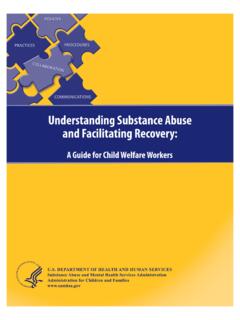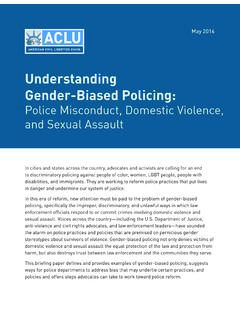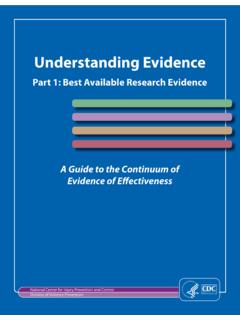Transcription of Topic 6: Understanding and managing clinical risk
1 Topic 6: Understanding and managing clinical risk Why clinical risk is relevant to patient medication errors and the strategies in place to safety 1 2 manage and avoid them. Risk management is routine in most industries and has traditionally been associated Research shows that nurses are more likely to with limiting litigation costs. Many corporations try report an incident than other health professionals, to avoid financial loss, fraud or a failure to meet certainly more so than doctors. This may be production expectations by implementing because the blame culture in medicine is a strong strategies to avoid such events. Hospitals and deterrent to reporting. Today, most risk health organizations use a variety of methods for management programmes aim to improve safety managing risks.
2 The success of a risk and quality in addition to minimizing the risk of management programme, however, depends on litigation and other losses (staff morale, loss of the creating and maintaining safe systems of care, staff, diminished reputation), but the degree of designed to reduce adverse events and improve their success depends on many factors. 3. human performance [1]. Many hospitals have well- established systems in place for reporting patient clinical risk management specifically is concerned falls, medication errors, retained swabs and with improving the quality and safety of health- misidentification of patients. Nevertheless, they care services by identifying the circumstances and are only beginning to focus on all aspects of opportunities that put patients at risk of harm and clinical care to see opportunities for reducing risks then acting to prevent or control those risks.
3 The to patients. following simple four-step process is commonly used to manage clinical risks: A medical student, along with everyone else who 1. identify the risk;. works in a hospital or clinic has a responsibility to 2. assess the frequency and severity of the risk;. take the correct action when they see an unsafe 3. reduce or eliminate the risk;. situation or environment. Taking steps to ensure a 4. assess the costs saved by reducing the risk slippery floor is dry and preventing a patient from or the costs if the risk eventuates. falling over is as important as ensuring that the medication a patient is taking is the correct one. In Medical students, along with all other health the event of a patient falling on a slippery floor or professionals will be mainly concerned about the receiving the wrong medication, it is equally risk to patients.
4 The first Topic in this Curriculum important for a student to report these events so Guide outlines the extent of the harm done by that steps can be taken to avoid future incidents. health care. It is against this backdrop that organizations are concerned about managing Effective risk management involves every level of clinical risks. clinical risk management allows the health service, so it is essential that all health- identification potential errors. Health care itself is care workers understand the objectives and inherently risky and although it would be relevance of the risk management strategies and impossible to eradicate all harm , there are many their relevance to their own workplace.
5 Activities and actions that can be introduced that Unfortunately, even though a hospital may have a will minimize opportunities for errors. clinical risk policy of reporting incidents such as medication is relevant to medical students because it errors, the actual reporting of them is often recognizes that clinical care and treatment are sporadic. Students can begin to practise reporting risky and incidents may to occur during clinical by talking with the health-care team about care and treatment. Students (as well as all other 151. Topic 6: Understanding and managing clinical risk health-care professionals) must actively weigh up after an adverse event;. the anticipated risks and the benefits of each respond appropriately to complaints.
6 clinical situation and only then take action. Students should seek out information about past WHAT STUDENTS NEED TO KNOW. risks and actively participate in efforts to prevent (KNOWLEDGE REQUIREMENTS). them recurring. For example, compliance with a handwashing protocol so that the spread of What are the activities for gathering infection is minimized. In this sense students are information about risk? 7. acting proactively to avoid problems and not Medical students working in hospitals may merely reacting to a current problem. not be immediately aware of a risk management programme in their hospital or clinic. Keywords Nevertheless, most countries today will have a clinical risk, reporting near misses, reporting range of mechanisms to measure the harm to errors, risk assessment, incident, incident patients and staff as well as avoid known monitoring.
7 Problems. Some countries have well-developed state and national data sets of incidents. In Learning objective 4 Australia, the Advanced Incident Management Know how to apply risk management System is a comprehensive approach to reporting principles by identifying, assessing and reporting incidents and analysing the various types of hazards and potential risks in the workplace. incidents. The Veterans Affairs Administration of the US Department of Veterans Affairs has Learning outcomes: knowledge and established a National Center for Patient Safety performance that uses a structured approach called root cause analysis to evaluate, analyse and treat the What students need to know (knowledge problems.)
8 See topics 5 and 7 for more requirements): 5 information about the root cause analysis the activities for gathering information methodology. T5 T7. about risk;. fitness-to-practice requirements; The principle underpinning root cause analysis is personal accountability for managing clinical that the actual (root) cause of a particular problem risk. is rarely (immediately) recognizable at the time of the mistake or incident. A superficial and biased What students need to do (performance assessment of any problem usually does not fix requirements): 6 the problem and more incidents will occur know how to report known risks or involving others in similar situations. An essential hazards in the workplace; part of any root cause analysis is the keep accurate and complete medical records; implementation of the findings of the root cause know when and how to ask for help from a analysis process.
9 Many hospitals and supervisor, senior clinician and other health- organizations fail to complete the process care professionals; because either the recommendations involve participate in meetings that discuss risk resources that are not available or there is no management and patient safety; commitment by the senior hospital management to respond appropriately to patients and families carry through the recommendations. 152. Topic 6: Understanding and managing clinical risk Some health-care organizations that mandate make a report again. Even when this happens, reporting of incidents can become so overloaded students should be encouraged by faculty staff to with reported incidents with the consequence that continue to report.
10 One day the student will be a many remain unanalysed due to inadequate senior doctor and their actions will be highly resources. Even the introduction of a triage system influential on younger doctors and students. to distinguish serious incidents from others has not Facilitated monitoring is designed to identify a resolved this dilemma in some systems. Many greater proportion of incidents and to produce systems now have borrowed from the Veteran reports that are aimed at improving care. This type Administration and introduced a severity of monitoring is a continuous activity of the clinical assessment code to help identify those incidents team involving the following actions: that indicate the most serious risk to the discussion about incidents is a standing item in organization.
















